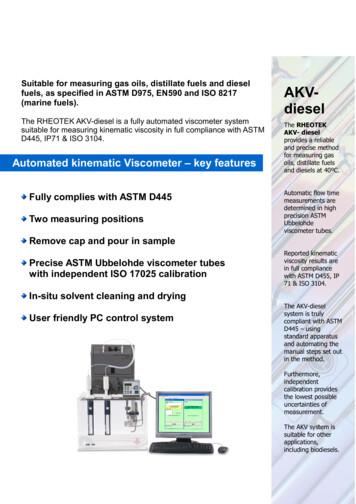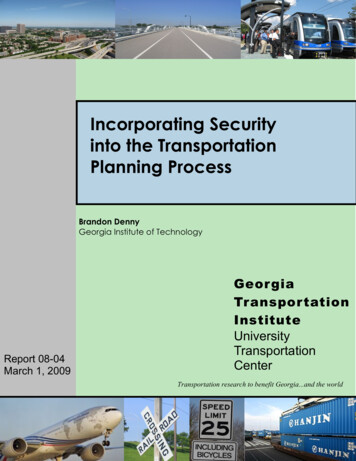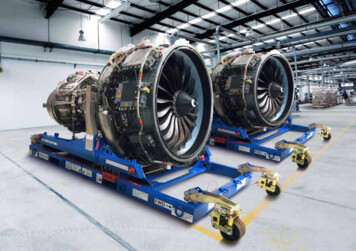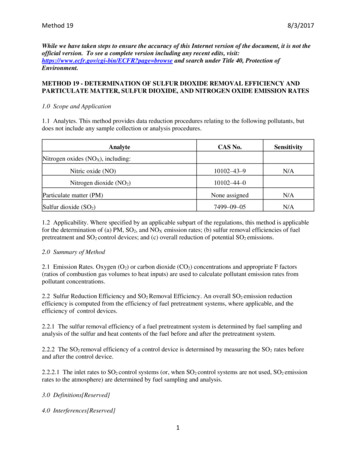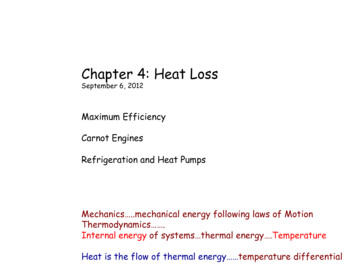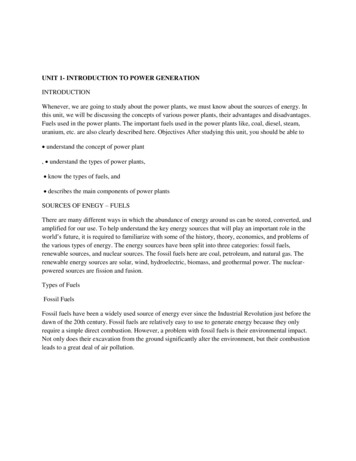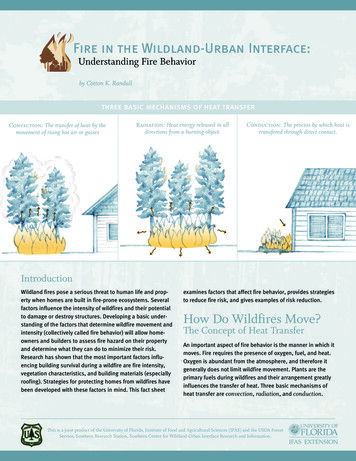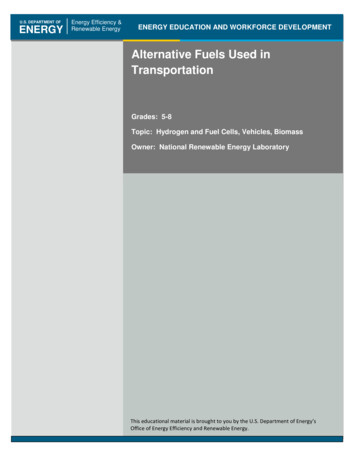
Transcription
U.S. DEPARTMENT OFENERGYEnergy Efficiency &Renewable EnergyENERGY EDUCATION AND WORKFORCE DEVELOPMENTAlternative Fuels Used inTransportationGrades: 5-8Topic: Hydrogen and Fuel Cells, Vehicles, BiomassOwner: National Renewable Energy LaboratoryThis educational material is brought to you by the U.S. Department of Energy’sOffice of Energy Efficiency and Renewable Energy.
This lesson plan may contain links to other resources,including suggestions as to where to purchase materials.These links, product descriptions, and prices may change over time.Alternative Fuels Used in TransportationFor the Teacher:The use of energy is a factor in all ourlives, and that is why it is important forus teachers to have our students learnabout the energy we use now and thenew forms of energy that are becomingavailable.Non-renewable energysources are diminishing everyday, and itis vital that students learn aboutrenewable energy sources to help themas they grow to become better informedand more responsible about the energyresources they use.Theuseofgasolinefortransportation is the most commonlyused fuel. However, there are multiplealternative fuels that are making theirways to the market. These alternativefuels include such things as propane,natural gas, electric hybrids, hydrogenfuel cells, and biodiesel.Students willprobably have heard of some of thesealternative fuels, but they may notunderstand how and why they arebetter then ordinary gasoline.Theprojects included in this section aredesignedtogivestudentstheopportunity to create their owninvestigation and test alternative fuelsand their relation to transportation.The projects included will fiteasily with regular classroom lessonssurrounding scientific inquiry and thescientific method.The projects have216of the capability to cross multipleeducation disciplines such as chemistry,physics, economics, and marketing andthey involve social interaction as well asgroup learning.Alternative fuels are beingresearched by top scientists every dayat NREL to discover which fuel methodswork best, how well they work and howeasily they can be distributed to thepublic. The authors of this section arestudying the emissions released fromlarge trucks running on differentbiodiesel fuels to compare which blendscreate lower emissions.National Science EducationStandards by the National Academyof Sciences:Science Content Standards: 5-8Science as Inquiry- Content Standard A:“Abilities necessary to do scientificinquiry”“Understandings about scientificinquiry”Physical Science- Content Standard B:“Properties and changes ofproperties in matter”“Transfer of energy”
This lesson plan may contain links to other resources,including suggestions as to where to purchase materials.These links, product descriptions, and prices may change over time.Earth and Space Science- Content Standard D:“Structure of the earth system”Science and Technology- Content Standard E:“Abilities of technological design”“Understandings about science andtechnology”Science in Personal and SocialPerspectives- Content Standard F:“Populations, resources, andenvironments”“Science and technology in society”Technology Description:Transportation by cars and trucksradically changed the face of ourcountry over the last hundred years,with petroleum providing the fuel forour vehicles. We use about 13 millionbarrels of oil each day to keep us on themove. Americans drive their personalvehicles about 2.3 trillion miles a yearwith 98 percent of our vehicles runningon petroleum or diesel fuels. UnitedStates imports two-thirds of all thepetroleum we use; therefore, cheaperand renewable alternative fuels wouldbe desirable to reduce our dependence.In addition to the dependence factor,one also needs to consider that theemissionsfromgasoline-poweredvehicles are fairly extensive and includeCO, CO2, NOx, SOx, VOCs, OH-, and PM.Some of these emissions are known orprobable human carcinogens, and1,3-butadiene(probable). Gasoline can also impact theenvironment if spilled, since it ssoilsandgroundwater.The idea of alternative fuels hasbeen around about as long as therebeen vehicles. In the 1880s, HenryFord built one of his first automobiles torun on ethanol. The alternative fuelsthat are being actively explored by nol;compressed and liquefied natural gas;electricity; hybrid electricity; biodiesel;and hydrogen fuel cells. Factors such ascost, fuel distribution, emissions, vehiclesystems analysis, energy storage, powerand propulsion systems, and advancedpower electronics are just some of theconsiderations in phasing in alternativefuels and advanced vehicle design.Complete CombustionFuel (hydrocarbons) Air (O2& N) CO2 H2O NTypical Engine CombustionFuel Air Unburned Hydrocarbons NOx CO CO2 H2OImproving fuel economy, cost,availability, and emissions are theprimarygoalsofresearchintoalternative fuels and transportation.Alternative FuelsMethanolMethanol, or wood alcohol, is acolorless,odorless,toxicliquid.Methanol is the simplest alcohol(CH3OH), produced by replacing one
This lesson plan may contain links to other resources,including suggestions as to where to purchase materials.These links, product descriptions, and prices may change over time.hydrogen atom of methane with ahydroxyl radical (OH). Methanol can beproduced from natural gas, coal,residual oil, or biomass.stored in pressurized tanks. Propane is270 times more compact in its liquidstate than it is as a gas, making it aportable fuel.Although vehicles can operate on puremethanolfuel(M100),methanolblended with 15 percent unleadedgasoline–M85- is more practical for realworld applications. Because methanol isa liquid fuel, it does not require majorchanges in the distribution system or incar engines, but no major automanufacturers offer M85 compatiblevehicles at this time. The cost of M85 isequal to or slightly higher than premiumblends.M85 has a lower energycontent per gallon, so mileage is lower;but power, acceleration and payloadcapacity are comparable to gasoline.Vehicles using methanol, however, mustuse a special, expensive lubricant.Propane has been used as atransportation fuel for more than half acentury and is the most widely used andmost accessible alternative fuel. Todayabout three percent of total propaneconsumption is used to fuel 270,000vehicles, mostly in fleets. For fleetvehicles, the cost of using propane is 5to 30 percent less than for gasoline.PropanePropane is an energy-rich fossil fueloften called liquefied petroleum gas(LPG). It is colorless and odorless; anodorant called mercaptan is added toserve as a warning agent. Propane is aby-product of petroleum refining andnatural gas processing. And, like allfossil fuels, it is nonrenewable. Thechemical formula for propane is C3H8.Undernormalatmosphericpressure and temperature, propane is agas. Under moderate pressure and/orlower temperature, however, propanecan easily be changed into a liquid and218EthanolEthanol is a clear, colorlessalcohol fuel made by fermenting thesugars found in grains—such as cornand wheat—as well as potato wastes,cheese whey, corn fiber, rice straw,urban wastes, and yard clippings. Thereare several processes that can producealcohol (ethanol) from biomass. Themost commonly used processes todayuse yeast to ferment the sugars andstarch in the feedstock to produceethanol. A new process uses enzymesto break down the cellulose in woodyfibers, making it possible to produceethanol from trees, grasses, and cropresidues.In the 1970s, the oil embargoesrevived interest in ethanol as analternative fuel. Today, more than fiftyethanol plants, mostly in the Midwest,produce over a billion gallons of ethanol.Gasolinecontainingtenpercent
This lesson plan may contain links to other resources,including suggestions as to where to purchase materials.These links, product descriptions, and prices may change over time.ethanol—E10—is widely used in urbanareas that fail to meet standards forcarbon monoxide and ozone. Sinceethanol contains oxygen, using it as afuel additive results in up to 25 percentfewer carbon monoxide emissions thanconventional gasoline. E10 is notconsidered an alternative fuel underEPACT, but a replacement fuel.MethaneMethane, the natural gas we usefor heating, cooking, clothes drying, andwater heating, can also be a cleanburning transportation fuel whencompressed (CNG) or liquefied (LNG).Compressed natural gas (CNG) vehiclesemit 85-90 percent less carbonmonoxide, 10-20 percent less carbondioxide, and 90 percent fewer d vehicles. (Reactivehydrocarbon emissions produce ozone,one of the components of smog thatcauses respiratory problems.) Thesefavorable emission characteristics resultbecause natural gas is 25 percenthydrogenbyweight;theonlycombustion product of hydrogen iswater vapor. Natural gas is usuallyplaced in pressurized tanks when usedasatransportationfuel.Evencompressed to 2,400-3,600 pounds persquare inch (psi), it still has only aboutone-third as much energy per gallon as219gasoline. As a result, natural gasvehicles typically have a shorter range,unless additional fuel tanks are added,which can reduce payload capacity. Withan octane rating of 120 , power,acceleration and cruise speed arecomparable.ElectricityIn 1891, William Morrison of DesMoines, Iowa, developed the firstelectric car. By the turn of the century,dedicatedelectricvehicles(EVs)outnumbered their gasoline-poweredcounterparts by two-to-one. Todaythere are about 10,500 dedicated EVs inuse in the United States, mostly in theWest and South. Researchers are stillworking on the same problem thatplagued those early dedicated EVs: theneed for an efficient battery.Thebatteries limit the range of a dedicatedEV, which is determined by the amountof energy stored in its battery pack. Themore batteries a dedicated EV can carry,the more range it can attain, to a point.Too many batteries can weigh down avehicle, reducing its load-carryingcapacity and range, and causing it touse more energy. The typical dedicatedEV can only travel 50 to 130 milesbetween charges. This driving rangeassumes perfect driving conditions dsomeaccessories use can significantly reducethe range.
This lesson plan may contain links to other resources,including suggestions as to where to purchase materials.These links, product descriptions, and prices may change over time.Hybrid ElectricityHybrid Electric Vehicles (HEVs) may bethe best alternative vehicle for the nearfuture, especially for the individualconsumer. HEVs offer many of theenergy and environmental advantagesof the dedicated electric vehicle withoutthe drawbacks. Hybrids are powered bytwo energy sources: an energyconversion unit (such as a combustionengine or fuel cell) and an energystorage device (such as battery,flywheel, or ultracapacitor). The energyconversion unit can be powered bygasoline, methanol, compressed naturalgas, hydrogen, or other alternativefuels. HEVs have the potential to betwo to three times more fuel-efficientthan conventional vehicles. An HEVbattery doesn’t have to be recharged. Ithas a generator powered by the internalcombustion engine to recharge thebatteries whenever they are low. Aregenerative braking system capturesexcess energy when the brakes areengaged. The recovered energy is alsoused to recharge the batteries.Gas-Electric HybridsBiodieselBiodiesel is a fuel made bychemicallyreactingalcoholwithvegetable oils, fats, or greases, such as220recycled restaurant greases. It is mostoften used in blends of two percent or20 percent (B20) biodiesel. It can alsobe used as neat biodiesel (B100).Biodiesel fuels are compatible with andcan be used in unmodified dieselengines with the existing fuelinginfrastructure. It is the fastest growingalternative transportation fuel in theU.S.Biodiesel contains virtually nosulfur, so it can reduce sulfur levels inthe nation’s diesel fuel supply.Removing sulfur from petroleum-baseddiesel results in poor lubrication.Biodiesel is a superior lubricant and canrestore the lubricity of diesel fuel inblends of only one or two percent.Biodiesel can also improve the smell ordiesel fuel, sometimes smelling likefrench fries.Berkeley Curbside Recycling Trucks Now Fueledby Recycled Vegetable OilHydrogen Fuel CellIn the future, hydrogen mayprovide a significant contribution to thealternative fuel mix. The space shuttlesuse hydrogen for fuel. Fuel cells usehydrogen and oxygen to produceelectricity without harmful emissions;water is the main by-product. Hydrogenis a gas at normal temperatures andpressures, which presents greatertransportation and storage hurdles thanliquid fuels. No distribution systemcurrently exists. Today, thepredominant method of producinghydrogen is steam reforming of natural
This lesson plan may contain links to other resources,including suggestions as to where to purchase materials.These links, product descriptions, and prices may change over time.gas, although biomass and coal can alsobe used as feedstocks.Alternate Transportation pdfEnergy Correlation to National ScienceEducation Content pdfProject Ideas1SunLine Transit AgencyHydrogen Fuel Cell BusResources:Energy Efficiency and Renewable Energyhttp://www.fueleconomy.gov/National Energy EducationalDevelopmenthttp://www.need.orgEnergy Efficiency and Renewable Energyhttp://www.eere.energy.govWhat is the heat content oftwo alternative fuels?Learning Objective: You will be ableto measure the amount of heatabsorbedbywaterduringthecombustion of methanol and ethanol ina calorimeter.Controls and Variables: Volume ofwater, temperature change in heat sink(100 ml of water), mass of fuel used,and heat content of two fuels.Materials and Equipment: Economycalorimeter; alcohol burners; ethanol;methanol; & thermometers.Kentucky Clean Fuels Coalitionwww.kentuckycleanfuels.orgU.S. Environmental Protection Agencywww.epa.govSafety and EnvironmentalRequirements: Safety glasses shouldbe worn at all times. The frame of theeconomy calorimeter retains heats andcare must be taken when moving aftertesting.National Renewable Energy Laboratory Department of Energywww.nrel.govSuggestions: Determine the number of chemicalbonds in methanol (5) and ethanol(8).221
This lesson plan may contain links to other resources,including suggestions as to where to purchase materials.These links, product descriptions, and prices may change over time. Correlate the heat content of eachfuel related to the number ofchemical bonds.Students explore why the obtainedheat values fall below the actual heatvalues (ethanol 7089 cal/g andmethanol 5426 cal/g).Do a balance of equations for thecombustion of methanol(2CH3OH 3 O2 2CO2 4H2O energy) and ethanol (C2H5OH 3 O2 2CO2 4H2O energy).Determine the oxygen to fuel ratiofor each fuel and how this ratiowould change the volume of carbondioxide produced.Wickless Leakproof Burnerhttps://www1.fishersci.com/wps/portal/HOME( 14.00, holds 100cc of fuel)https://www.freyscientific.com( 13.65, holds 100cc of fuel)Flint Glass Alcohol Lamphttps://www.freyscientific.com( 6.25, 8 oz. E( 6.35, 8 oz. tal/HOME( 10.80, 1 liter)Places To s/portal/HOME( 25.60, economy food calorimeter)https://www.freyscientific.com( 8.35, 1 liter)https://www.freyscientific.com( 21.95, economy food calorimeter)A homemade calorimeter can bemade by using two different size canswith holes through the top of both cansto suspend the smaller can over theflame with glass stir rod. The larger canis a tube and the smaller can opens onlyon top, to hold water and taketemperature readings (Note ps/portal/HOME( 5.15, 500 ml)https://www.freyscientific.com( 6.65, 500 ml)2What is the economicallybest choice betweenpurchasing a hybrid or atypical gasoline engineautomobile?Learning Objective: You will be ableto show which type of engine is themost economical in the long runbetween a hybrid and typical gasolineengine.222
This lesson plan may contain links to other resources,including suggestions as to where to purchase materials.These links, product descriptions, and prices may change over time.Controls and Variables: The differentvariables for each automobile will be theinitial cost, the operating cost (gasolineprice), and the miles per gallon of fuel.Constants should be the amount ofdriving that would be done in eachautomobile.Materials and Equipment: Pen, paperand access to the Internet for research.Safety and EnvironmentalRequirements: NoneSuggestions: The payback period is the length oftime you must own an energyefficient vehicle before the decreasedoperational costs make up for thedifference in initial purchase price.Calculate the payback period for aHonda Civic (Hybrid) vs. a HondaCivic (Gasoline) using the followingfigures:Honda Civic (Hybrid)Initial Cost: 19,650Tax Incentive: 1500Miles per Gallon: 48 mpgHonda Civic (Gasoline)Initial Cost: 17,260Tax Incentive: 0Miles per Gallon: 40 mpgInitial CostTax IncentiveFuel EconomyHybrid 19,650 1,50048 mpgGasoline 17,260 040 mpgDifference in( ) 2390Initial costDifference in costafter tax incentive ( ) 890Fuel economy at agas rate of 2.10per gallon for 525/yeaone year at 10,000 438/year rmilesAmount of time tillhybrid savingsexceed gasoline 10.2yearsinitial savings 3Investigate the rate at which hybridvehicles have been decreasing ininitial cost. What might be somefactors for this decrease? Do theyexpect hybrid vehicles to somedayhave a lower initial cost thengasoline engine vehicles?Research other types of alternativefuels. Is a hybrid more costefficient then compressed naturalgas (CNG), hydrogen fuel cells,propane, or biodiesel?Determine a plan for largenumber fleets of automobilesto transition for traditionalgasoline engines toalternative fuel engines.The mayor of a large city in yourarea has asked your class to develop aplan to reduce emissions created by hisfleet, including school buses, public223
This lesson plan may contain links to other resources,including suggestions as to where to purchase materials.These links, product descriptions, and prices may change over time.buses, sanitation trucks, police,emergency vehicles, and the city fleet ofautomobiles. Divide the project into sixparts and in each part develop a plan topresent to the mayor, listingrecommendations and costs for eachtype of vehicle and the rationale foreach recommendation.List the recommendations of eachpart by vehicle category. Where thereare several recommendations, debateand defend recommendations until aconsensus is reached.Learning Objective: You willunderstand different forms of alternativefuels as well as a greater understandingof citywide economics.Controls and Variables: NoneMaterials and Equipment: Pen, paperand access to the Internet for research.Safety and EnvironmentalRequirements: NoneSuggestions: Invite area experts tovisit the classroom to discuss alternativefuel vehicles.Learning Objective: You will be ableto test for the presence of CO2 in thecombustion of ethanol and methanoland qualitatively compare the twoamounts.Controls and Variables: The differentamounts of ethanol and methanol thatare used can either be held constant orvaried depending on the experiment.Hold the solution of bromothymol blueor red cabbage juice constant througheach test.Materials and Equipment: A fishaquarium air pump with tubing, airpump in sealed container with inlet andoutlet air tubes, two test tubes, scale todetermine mass of fuel consumed,material from project #1, bromothymolblue solution or red cabbage juice, andstopwatch.Safety and EnvironmentalRequirements: Safety wear (goggles,lab apron, heat resistant gloves), wellventilated area for burning, and wastecontainer. (Do not pour ethanol ormethanol down the drain or intogarbage.)Present your findings in a formal reportto be sent to your local mayor.4tube of bromothymol blue solution orred cabbage juice to determine therelative CO2 content.(Bromothymolblue will change from blue to green toyellow in the presence of CO2.)Quantify the relative amountof CO2 given off by themethanol vs. ethanol duringthe combustion process.Utilize a fish aquarium pump topull samples of exhaust fumes fromabove the calorimeter experiments(done in project idea one) and let itpump the collected gases into a test224
This lesson plan may contain links to other resources,including suggestions as to where to purchase materials.These links, product descriptions, and prices may change over time.Safety and EnvironmentalRequirements: Safety protectionshould be taken when building the carsfrom scratch. You also requireprotection from small electrical circuitsand a moving motor.Places to Purchase:Bromothymol Blue, 0.04% in Ethanolhttp://www.baddley.com/ ( 12.00 – 125ml)http://www.clarksonlab.com/salesaz.htm ( 14.95 - 5 g powder reagent)5What goes into building ahydrogen fuel cell car?Therearemanydifferentavailable models of hydrogen fuel cellcars that can be bought. Try just usingthe basic parts to build a uniquehydrogen fuel cell vehicle.Learning Objective: You will be ableto understand the hydrogen fuel cellprocess of how water (throughelectrolysis) is turned into power to runa motor.Controls and Variables: A simplehydrogen fuel cell vehicle kit will give allthe components necessary; everythingelse is up to you.Materials and Equipment: Hydrogenfuel cell vehicle kit, some power toolsmay be necessary when building customvehicle bodies.You will also needsmooth surface to run the vehicles on.225Suggestions:1.See who can build the fastestvehicle by changing wheels and axis,body types, and gear sizes.2.Determine the efficiency of thehydrogen fuel cell.Places to Purchase:Hydrogen Fuel Cell uelcell.htm( 125)http://sciencekit.com/category.asp Q cE 427448( 220)
This lesson plan may contain links to other resources,including suggestions as to where to purchase materials.These links, product descriptions, and prices may change over els.pdfPhoto Fuels.pdf226
Propane is an energy-rich fossil fuel often called liquefied petroleum gas (LPG). It is colorless and odorless; an odorant called mercaptan is added to serve as a warning agent. Propane is a by-product of petroleum refining and natural gas processing. And, like all fossil fuels, it is nonr
